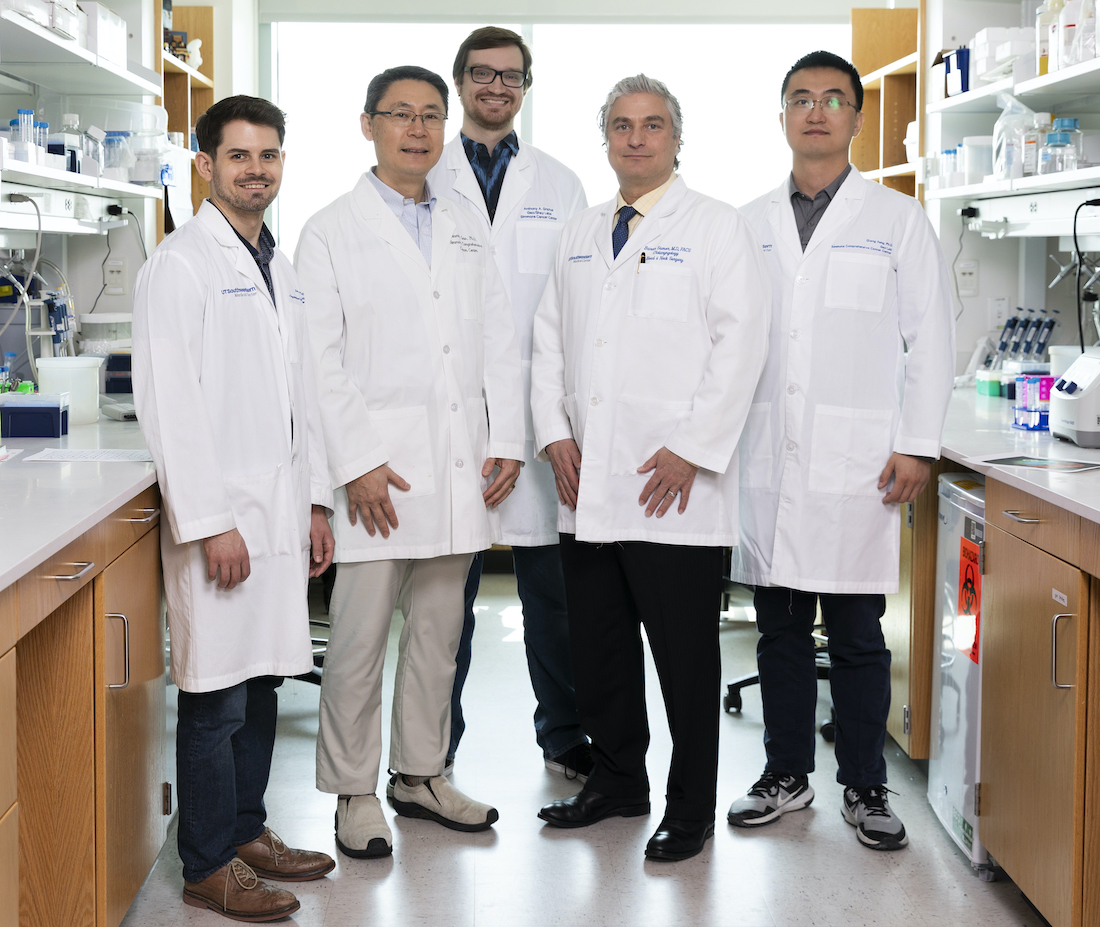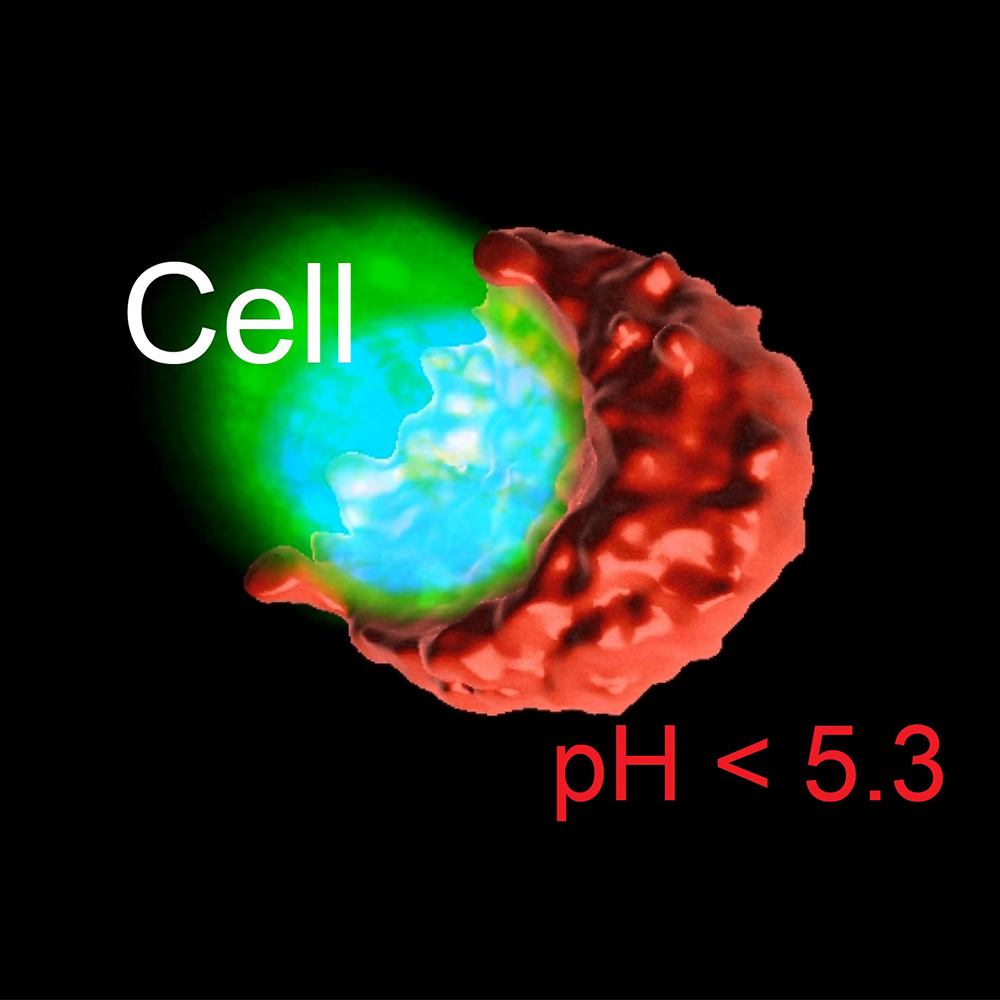UTSW discovers protective ‘acid wall’ formed by cancer cells
Higher acidity levels on outer edges of tumors could rebuff immune cells

DALLAS – April 01, 2024 – Cancer cells release a significantly more concentrated level of acid than previously known, forming an “acid wall” that could deter immune cells from attacking tumors, UT Southwestern Medical Center scientists show in a new study. Their findings, published in Nature Biomedical Engineering, could pave the way for new cancer treatment approaches that alter the acidic environment around tumors, the researchers say.
“This study revealed a previously unrecognized polarized extracellular acidity that is prevalent around cancer cells,” said study leader Jinming Gao, Ph.D., Professor in the Harold C. Simmons Comprehensive Cancer Center and in the Departments of Biomedical Engineering, Cell Biology, Otolaryngology – Head and Neck Surgery, and Pharmacology at UT Southwestern.

For nearly a century, scientists have known that tumors are acidic (that is, their pH, a measure of acidity, is below 7) but only slightly more than most healthy tissues in the body. For example, the average pH of human muscle at rest is about 7.4, but the average pH of malignant human tumors is about 6.8.
Several years ago, Dr. Gao and his colleagues designed a set of nanoparticles that disassemble and release a fluorescent signal that lights up at specific levels of acidity. They found that one called pegsitacianine allowed a variety of tumors to fluoresce brightly, which may have value for identifying cancer during surgical resection. This nanoparticle is now in development by OncoNano Medicine and has progressed through phase two development in patients as a tool for image-guided cancer surgery. In 2023, pegsitacianine received Breakthrough Therapy designation by the U.S. Food and Drug Administration, a step that expedites the development and review of promising medicines. However, Dr. Gao said, it was unclear why these nanoparticles fluoresced since a tumor’s acidity was thought to be too mild to trigger their activation.
To answer this question, he and his colleagues imaged individual cells sampled from a variety of human and mouse cancer types – including lung, breast, melanoma, and glioblastoma – using nanoparticle probes. They found that the probes lit up on one side of the cancer cells but not the other, suggesting that their acidity was polarized. This acidity results from the secretion of lactic acid, which tumor cells produce as a waste product after digesting glucose, or blood sugar. When they did similar experiments in tumor tissue, imaging showed that the cancer cells preferentially pumped acid away from neighboring cancer cells and into the extracellular environment, forming a zone of higher acidity at the tumors’ edge.
Samples from human tumors showed that this acid wall was practically devoid of CD8+ T cells within the tumors, an immune cell type known to fight cancer. When the researchers grew cancer cells and CD8+ T cells together in petri dishes that had been acidified to a 5.3 pH, the cancer cells were spared while the CD8+ T cells perished within three hours, suggesting that this severe acidity might thwart immune cell attack without harming the cancer cells.
Previous research from the Gao Lab has shown that lactate, the basic counterpart of lactic acid, enhances the anti-cancer activity of immune cells. Since lactic acid appears to do the opposite, future treatment strategies may focus on converting lactic acid to lactate to promote an immune attack, Dr. Gao said. Other potential treatments currently under investigation at UTSW and elsewhere that harness tumors’ relative acidity, such as pH-sensitive drug carriers that release chemotherapy inside tumors, could need adjustments based on the higher acidity revealed in this study, he added.
Dr. Gao noted that this discovery will lead to several new lines of research, such as studies to better understand how cancer cells polarize their acid excretion, how those cells can withstand the acidity level that kills CD8+ T cells, and how to inhibit acid excretion to allow T cells to better kill cancer cells.
Other UTSW researchers who contributed to this study include first author Qiang Feng, Ph.D., Research Scientist; Ralph DeBerardinis, M.D., Ph.D., Professor in the Children’s Medical Center Research Institute at UT Southwestern, the Eugene McDermott Center for Human Growth and Development, and Pediatrics, and Chief of the Division of Pediatric Genetics and Metabolism; Mingyi Chen, M.D., Ph.D., Professor of Pathology; Baran D. Sumer, M.D., Professor of Otolaryngology – Head and Neck Surgery; Gang Huang, Ph.D., Assistant Professor in the Simmons Cancer Center and Pharmacology; Zachary Bennett, Ph.D., postdoctoral researcher; Anthony Grichuk, B.S., graduate student researcher; and Raymundo Pantoja, B.A., research assistant.
Dr. Gao holds the Elaine Dewey Sammons Distinguished Chair in Cancer Research, in honor of Eugene P. Frenkel, M.D.
Dr. DeBerardinis holds the Joel B. Steinberg, M.D. Distinguished Chair in Pediatrics and is co-leader of the Cellular Networks in Cancer Research Program of the Simmons Cancer Center, an Investigator of the Howard Hughes Medical Institute, and a Sowell Family Scholar in Medical Research.
Dr. Sumer holds the T.C. Lupton Family Professorship in Patient Care, in Honor of Dr. John Dowling McConnell and Dr. David Andrew Pistenmaa and is a member of Simmons Cancer Center.
This study was funded by grants from the National Institutes of Health (R01CA211930 and R01CA13291074), the Cancer Prevention and Research Institute of Texas (RP180343), and the Mendelson-Young Endowment in Cancer Therapeutics as well as a National Cancer Institute Cancer Center Support Grant (P30CA142543).
Drs. Gao and Sumer are scientific co-founders and advisers of OncoNano Medicine Inc., which has exclusive rights to this technology and is developing it as a potential imaging agent for cytoreductive oncology surgeries. Dr. Huang is a scientific adviser and royalty recipient of OncoNano Medicine. UT Southwestern also receives licensing income from OncoNano Medicine.
About UT Southwestern Medical Center
UT Southwestern, one of the nation’s premier academic medical centers, integrates pioneering biomedical research with exceptional clinical care and education. The institution’s faculty members have received six Nobel Prizes and include 25 members of the National Academy of Sciences, 21 members of the National Academy of Medicine, and 13 Howard Hughes Medical Institute Investigators. The full-time faculty of more than 3,100 is responsible for groundbreaking medical advances and is committed to translating science-driven research quickly to new clinical treatments. UT Southwestern physicians provide care in more than 80 specialties to more than 120,000 hospitalized patients, more than 360,000 emergency room cases, and oversee nearly 5 million outpatient visits a year.
